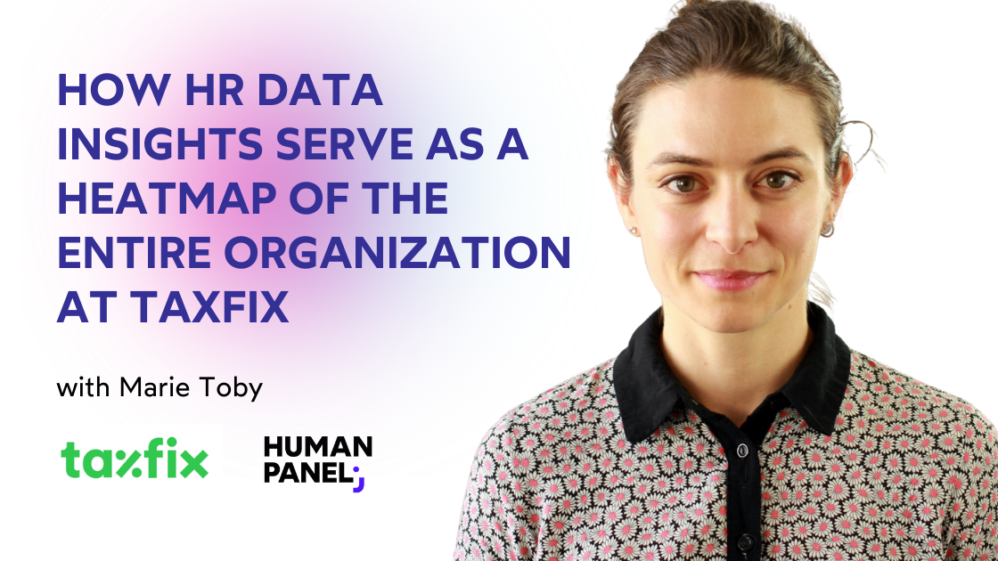Skills of the future. How to move to skills-based workforce planning?
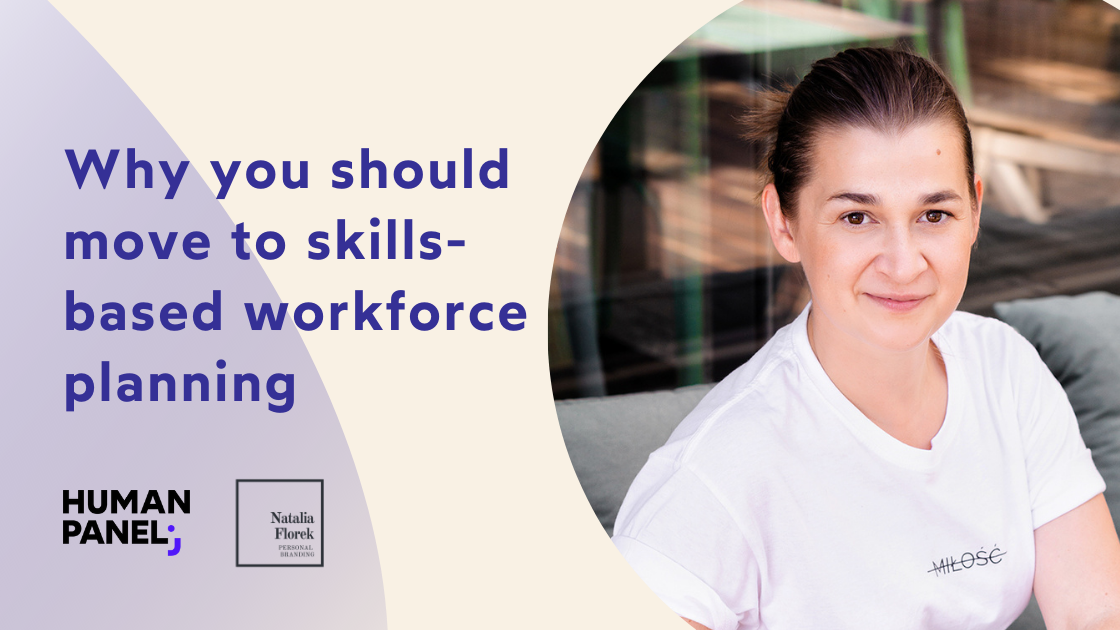
What are the skills of the future and how do you know if you need them in your organization?
The Future of Jobs Report says that 85 million jobs could disappear by 2025 due to the shift of work between humans and machines. At the same time, 97 million new jobs could be created, which means about 50% of us will need to reskill at some point. Upskilling and reskilling have taken on a new urgency – and so has skills-based workforce planning.
The pandemic has already shown us that flexibility and agility are essential if we want to adapt to a rapidly evolving workforce. According to the International Labor Organization (ILO), more than 140 million people are out of work. At the same time, many industries continue to struggle to find the right talent and close the skills gap. The number of job openings in the US and the UK has reached record levels. Many talent acquisition leaders have acknowledged that we are in a “war for talent”.
The skills of the future
Many businesses are aware that digital transformation, automation, AI, cloud computing, and new technologies are making some roles disappear while creating new ones. A vast majority (94%) of business leaders say they expect their employees to learn new skills on the job – a significant increase from 65% in 2018. The pace of technological advancement means that the ability to learn is becoming critical in the job market. But what exactly are these “skills of the future”?
“They are the skills we can’t automate and duplicate, where a human will always be better than a machine,” says Natalia Florek, who advises companies and candidates on how to prepare for tomorrow’s job market. “We are seeing profound automation of processes, and, certainly, we will soon be doing things differently. So we need to try to stay ahead of change and develop new skills,” she adds.
If you ask yourself, ‘Can we automate what I do?’ and the answer is ‘yes,’ that means you need to look for new learning opportunities.
Natalia Florek
According to The Future of Jobs Report, the amount of time humans and machines spend on current workplace tasks will likely be equal by 2025. The same report says that the 15 most important skills of the future will include:
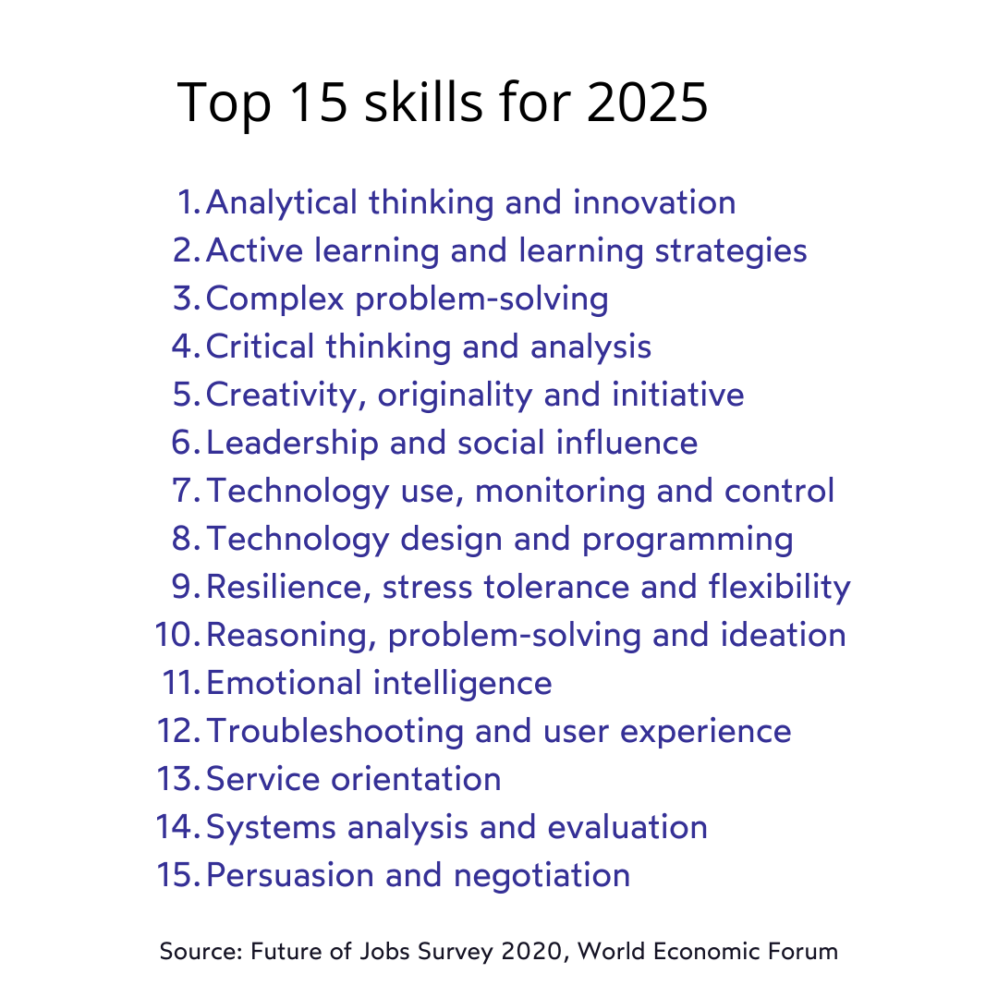
“As we can see, there are both ‘hard’ and ‘soft’ skills in this set. Hard ones – like digital and technology skills, analytics or data literacy. And soft ones whose demand has not changed for decades. For example, creativity is one of the most important skills of all, as is emotional intelligence,” Natalia Florek comments.
What can companies do to find people with exactly the skills they need?
“Today, most companies use special software to scan candidates’ resumes and fish out keywords and terms. On the other hand, it’s easy to edit an application so that it falls through the first sieve. Then a company has to test the applicant’s skills in an interview or assessment center,” says Natalia Florek.
Sometimes the candidates are not aware of their skills and competencies that can count in hiring. “This is why I always recommend putting skills at the top of your CV and showcasing your value to the potential employer,” Natalia Florek adds.
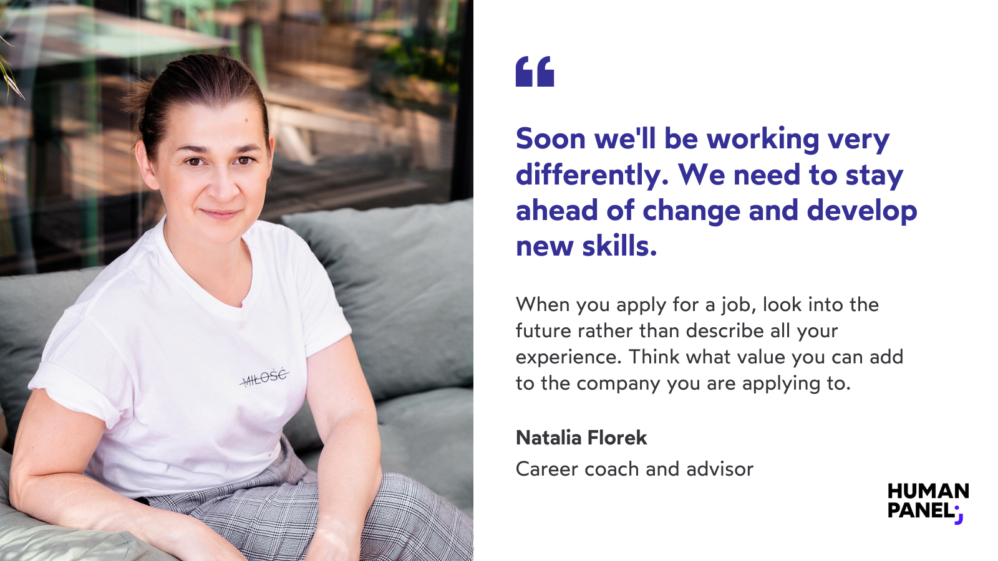
What is skills-based workforce planning?
In the future of work evaluating employees and new hires based on their skills, rather than their work history, can help companies close the skills gap and create a more diverse workforce. Last year, LinkedIn saw a 21-percent increase in job postings in the US citing skills and responsibilities instead of qualifications and requirements. The number of jobs not requiring a college degree increased by nearly 40% in 2020 compared to 2019.
But what exactly is skills-based workforce planning and how does it differ from more traditional, function-based planning?
In the past, companies planned for employment by assessing the supply and demand for specific jobs over a given time horizon. They simply asked: How many employees do we need?
“The typical assumption was that these jobs would not change very much; that job titles, responsibilities, business processes, performance measures, and required skills would remain largely the same,” wrote Ruth Ebeling, Managing Director & Partner at Boston Consulting Group, in her LinkedIn article.
Technology disruption and the shift in the labor market caused by Covid-19 are forcing companies to rethink role-based workforce planning. The skills-based workforce planning approach adds a new dimension to the supply and demand model by asking a different question: What kind of employees do I need? What are the critical skills and capabilities we need as a business to deliver on our priorities?
In other words, skills-based workforce planning means that each person is a composition of skills, not just a “role” or “a function”.
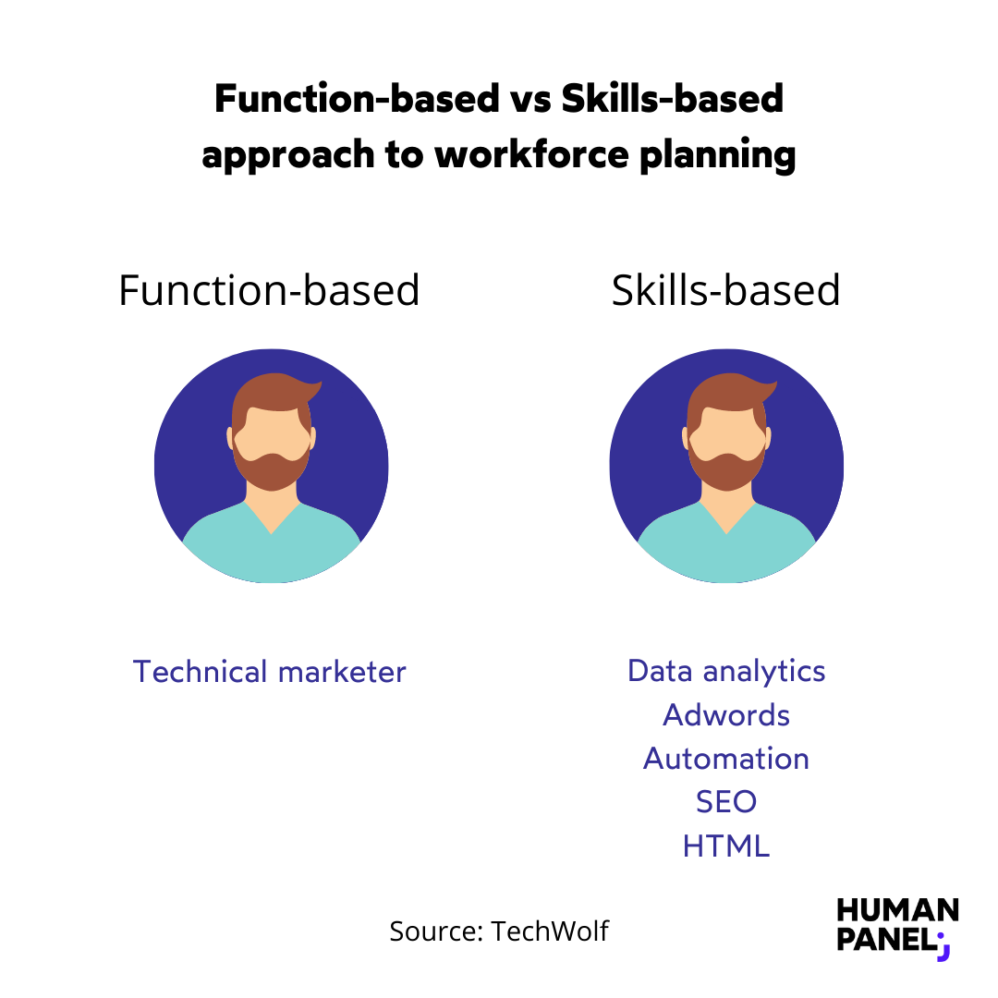
Abandoning the old models of workforce planning
Why are the “old” models of workforce planning no longer effective? Technological upheaval, automation, and remote work have forced many companies to adopt more flexible ways of working. Some jobs may soon disappear or be automated, but we will still need people with certain skills. And that’s why it’s important to understand what those skills are.
Sometimes companies – and employees themselves – do not realize that they have skills that can be easily transferred from one job to another. For example, many food servers lost their jobs because of the pandemic, but more than 70% of them have the skills needed to succeed in customer service.
Most companies still rely on manual processes to create employee profiles that include the job title and some basic demographic information. This type of data says nothing about whether an employee can perform a particular task. Neither does it say whether a company needs to develop certain skills internally or bring them in from the outside.
In many organizations, the data is scattered across different tools and systems and lacks context. As a result, executives do not have access to data about their employees’ skills. A study by Mercer found that only two in five HR executives feel they have a clear idea of their employees’ skills.
The benefits of skills-based workforce planning
As we mentioned earlier, 50% of us will need reskilling at some point. According to the World Economic Forum research, most jobs will require 10 new skills within 18 months, and 65% of today’s jobs will have disappeared by 2035.
At the same time, Gartner Talent Neuron data shows that the number of skills required for a single job increases by 10% every year. So if you want your business to grow, you need to know the extent to which your workforce can deliver on strategic priorities. Do your employees have up-to-date skills? Do you have the right number of people with the right skills to deliver the results you want, enter a new market or launch a new product?
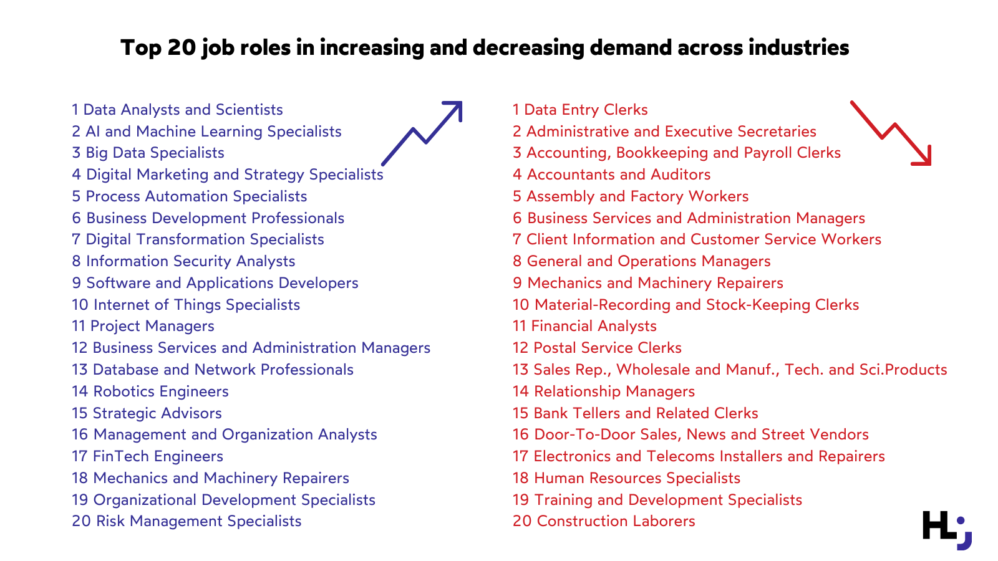
The ability to assess employee skills gives companies the chance to extrapolate their strategic direction and close the skills gap. In addition, knowing one’s skill set empowers individuals and gives them a better understanding of their value to the company.
Since skills are becoming more important than education, experience, or personal referrals, your workforce is also becoming more diverse, which can result in stronger retention. Employees without a traditional four-year degree stay at companies 34% longer than those with a degree, according to LinkedIn research.
The same source also states that US job posts that mentioned “responsibilities” and not “requirements” received 14% more applications per view than job posts that mentioned “requirements” but not “responsibilities“.
Solutions
So what can you do to start your skills-based workforce planning? As Ralf Buechsenschuss, Global Head of Org Design, Analytics, and Digitalization at Zurich Insurance Company, said in an interview with David Green, the starting point is your business priorities. Where do you want to take your business? How can you adapt the organizational framework to meet those needs?
Once you have defined your goals, you can start working with data by using people analytics solutions, such as Human Panel. The key is to integrate all your scattered data into one database. Talent acquisition, performance management, and talent development all have valuable data points about competent skills. But you need to correlate these data points to achieve an effective, data-driven strategy.
I think the role of people analytics in many organizations is to help employees understand how to stay relevant in the job market. Analytics can also provide a very clear view of where you need to train or retrain as a professional.
Ralph Buechsenschuss
What can help here is skills inference. It is data analytics that extracts semantic information about employee skills to reveal the value of employee knowledge. Skills inference helps you define the skills you have in your organization and those you will need in the future. This way you can decide what training is needed and who needs to be retrained or upskilled. Find out more about skills inference here.
Conclusion
Companies around the world are seeing the need to upskill their current talent and are planning employment based on skills. Some are trying to “future-proof” their employees by equipping them with the skills needed to adapt to changing work.
Amazon, for example, has invested more than $700 million in employee training. PwC is spending $3 billion to train all of its 275,000 employees over the next three to four years. The pandemic has accelerated this need for companies of all sizes – including yours.
Don‘t wait for the next crisis to change your attitude. Use the power of modern technology and data to prepare for tomorrow’s world. Hire for the future, not the past – with a little help from people analytics and strategic planning, you’ll achieve the business goals you want, and the sky will be your limit. See how Human Panel can help you in achieving your goals. Sign up for a free demo and get ready for the future.
Discover all Human Panel features




